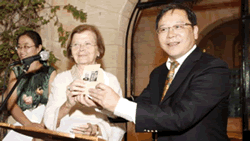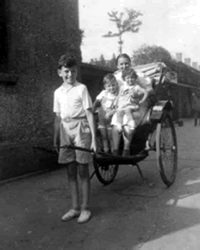Saved in Shanghai — a young girl’s story highlights a rare WWII place of refuge
20,000 Jews were protected from the Holocaust in the Japanese-occupied city. Nina Admoni, whose husband would later head the Mossad, was one of them
BY MICHAL SHMULOVICH August 25, 2012,

WRITERS

Michal Shmulovich
Follow or contact:
RSS
NEWSROOM
Email the Newsroom
Facebook
Twitter
RELATED TOPICS
JEWISH REFUGEES
SHANGHAI
HOLOCAUST
Nina Admoni (née Wertans) was six when Germany invaded her native Poland. Fleeing falling bombs and seeing starving people beg for food along the Trans-Siberian Railway were some of her first encounters with World War II.
Still an active woman who wakes up at 5 a.m. each day at her home in Tel Aviv’s Ramat Aviv Gimmel, Admoni, now 79, headed the Israel-America Chamber of Commerce for 26 years. She looks back on her experience in Shanghai fondly, even idyllically. “The Chinese people in Shanghai were very kind,” she said softly. “That’s what I remember.”
“The idea, when the war first started, was to go to Vilna/ Vilnius,” she said, because that’s where her mother was from and where her grandfather was a leader in the Jewish community.
So the family drove to Vilnius, “bombs falling on the way.” But the Soviets entered the area fairly soon afterwards. “My father was considered a capitalist, and it was not terribly nice for him. He was concerned, but he was more concerned that the Germans were coming soon.”
They looked for a way out, and heard that a Japanese Consul in Kaunas, Lithuania, a man named Chiune Sugihara, was issuing transit visas for Jews through Japan. By going against orders and issuing Jews such visas, Sugihara saved more than 3,000 people.

Nina Admoni (center) donating her Nankin-issued Polish passport to the Shanghai Jewish Refugees Museum, accepted by Li Guohua, deputy mayor of Hongkou district, Shanghai, which housed Jewish refugees during WWII, during a ceremony in Jerusalem (photo credit: Flash90)
But in order to get a transit visa, you need an end visa, she went on, in a recent interview with The Times of Israel. “My parents received a paper from the Dutch consul that stated that in order to go to Curaçao (a former Dutch island off the coast of Venezuela), one did not need an entry visa.” This document essentially served as an end visa for her family, and others, because it provided them with a destination.
“On the basis of that piece of paper, the Japanese consul gave us a transit visa (in 1940), and we also got an exit visa from the Soviets” — not a small feat at the time because people could not “come and go as they pleased,” she added.
“My father bought tickets from Intourist [the travel agency] and we took a train to Moscow, and then the Trans-Siberian Railway to Vladivostok, a 10-day trip. You had to pay in dollars,” Nina said. And it was extremely dangerous to be found with dollars at that time.
When the train stopped along the route people banged on the windows, begging for food. “It was a very sad sight,” Nina said.
The family then took a ship from Vladivostok to Suruga, a Japanese port. From Suruga they went to Kobe, one of Japan’s main cities, where she entered first grade at St. Marie’s School. It was run by nuns, but she was excused from “crossing” herself, she recounted, smiling.
While in Japan, they were temporarily put up in a very nice hotel, and the Jewish community came to help. “I thought the Japanese were very nice… There were flowers everywhere, the hotel opened up into a garden. Everyone took their shoes off when entering. It was lovely,” she said.
After just a few months, the local authorities reminded them that they were in Kobe on a transit visa only. They had to move on.
The only place that would receive them was the open city of Shanghai.
Stateless Jews
Shanghai, China’s main port city and business capital, had become a vivacious melting pot, a unique blend of East-meets-West. With traces of its traditional past, evident in things like the historic shikumen houses, Shanghai mixed the enchantment of the Far East with international flair, courtesy of the eight countries — the US, UK, France, Russia, Italy, Austro-Hungary, Japan, and Germany — which had been given territorial concessions across the city during the 19th century.
During World War II, some 20,000 Jews found refuge from the Holocaust in the vibrant Chinese city. David Kranzler, a noted Holocaust historian, calls it the “miracle of Shanghai” — a rare bright spot in the dark tragedy of that era.
The story of the Jewish refugees in Shanghai is the subject of a small new exhibit now briefly on in Jerusalem, in which family artifacts and photographs give glimpses of some of the refugees’ stories. On loan from the Shanghai Jewish Refugees Museum, the exhibit coincides with the 20th anniversary of diplomatic relations between China and Israel.

Shanghai’s Bund, a main fairway, in 1928. Shanghai was a haven for tens of thousands of Jewish refugees during World War II. (photo credit: Wikimedia Commons)
Shanghai, an international city, was divided into sections — the British International Settlement and the French Concession.
Nina’s family first moved to the French Concession. They lived on Avenue Joffre. But by late 1943, the Germans told the Japanese that the Polish Jews were “stateless” — Poland no longer existed, as it was under German rule, they claimed. The Germans demanded that Shanghai’s “stateless Jews” be moved to a designated area, where the poor German and Austrian Jewish refugees already lived.
The Russian and Baghdadi Jews helped by arranging housing, and they got some assistance from Jewish groups. Life in the designated area — the ghetto –was harsh. But it proved safe.

Jewish refugees take a rickshaw for a ride in Shanghai during World War II (photo credit: courtesy, Shanghai Jewish Refugees Museum)
Nina, as a young girl, was free to leave the area and play with her friends; her father, on the other hand, was not allowed to move around, and could not continue the work he had found as an engineer. People needed passes to leave the designated area, passes, which became increasingly difficult to obtain.
With hours of free time on his hands, he taught his daughter geography, history, mathematics, and literature. “He had a large map on the wall, and he followed the war closely, using pins to mark the progress of the war… That’s how I learned.”
“I was young, and I really enjoyed playing with my Chinese friends — although I didn’t speak a word of Chinese. You know, at that age you don’t really need a common language; children find ways to speak to each other. We played a lot of games,” she recounted, nostalgia in her voice.
Thanks to good fortune and kindness, Nina’s childhood years in Hongkou (Hongkew), Shanghai were a world apart from the horrors of Europe. She played hopscotch with her Chinese and Jewish friends and wandered along the Bund, the city’s main fairway, to and from school each day.
Nina attended the excellent Shanghai Jewish School — “with the best teachers.” As the war progressed, though, some of her teachers were interned at camps because they carried British passports. While war destroyed the lives of so many children in distant Europe, Nina’s concerns were whether she would be first, or second, in her class. She did not know the extent of the horrors at the start of the Holocaust — and if her parents did, they shielded her from the devastation.
Still, she does remember the American B-29 planes’ bombardment of Shanghai, several years after Pearl Harbor.
After the war
Shortly after the war, aged 14, carrying mostly memories, Nina parted ways with her Chinese neighbors and her classmates, and came to California.
The hours of lessons with her father paid off. When she entered an elite school in New York City, she skipped two grades. “They would have moved me up another grade, but I didn’t have enough American history background.” Nevertheless, she graduated high school at age 16.
When asked where she feels most at home, Nina answered without missing a beat — “Israel.”
But when asked where she feels that she grew up? “Shanghai… and maybe Berkeley.”
It was at Berkeley that she met her husband, Nahum Admoni — an Israeli student born in Jerusalem — who whisked her away to Israel, where he later rose through the ranks of the country’s intelligence establishment.
From 1982-89, Nahum served as the head of the Mossad — the clandestine Israeli organization that helps safeguard Israelis and Jews around the world.
Nina Admoni must have particularly recognized the importance of that work, given her own family’s story of wartime survival.
The temporary exhibit from the Shanghai Jewish Refugees Museum can be seen at the Jerusalem Quality House this weekend. It has also been on display in Haifa. For more information, please visit this website.